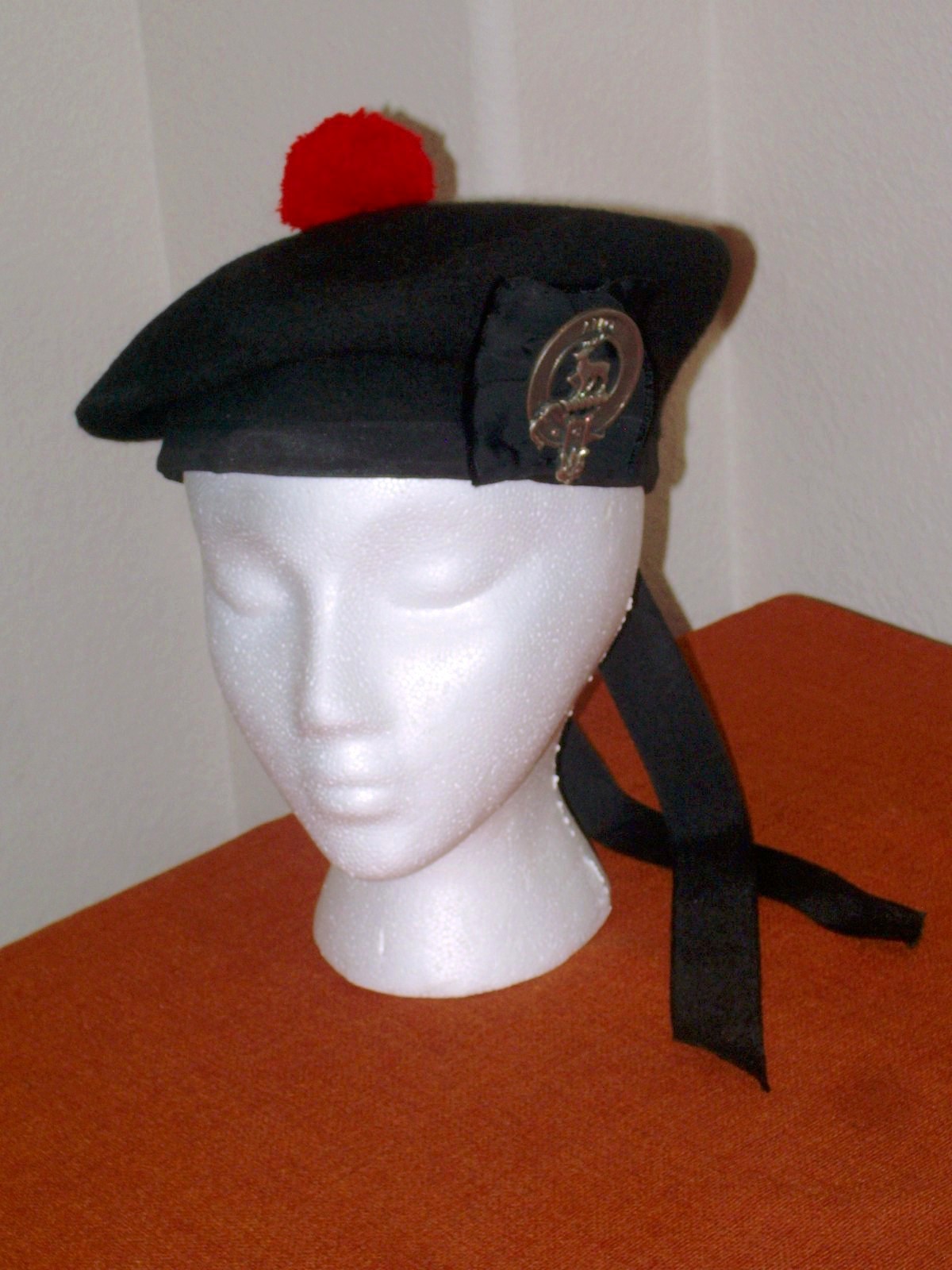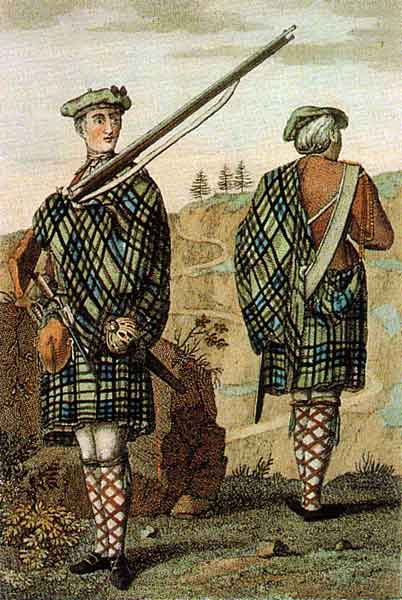Balmoral Bonnet on:
[Wikipedia]
[Google]
[Amazon]
 The Balmoral bonnet (also known as a Balmoral cap or Kilmarnock bonnet) is a traditional Scottish hat that can be worn as part of formal or informal Highland dress. Developed from the earlier blue bonnet, dating to at least the 16th century, it takes the form of a
The Balmoral bonnet (also known as a Balmoral cap or Kilmarnock bonnet) is a traditional Scottish hat that can be worn as part of formal or informal Highland dress. Developed from the earlier blue bonnet, dating to at least the 16th century, it takes the form of a
 As worn by Scottish Highland regiments, the blue bonnet (common civilian headwear) gradually developed into two military forms. One was the Balmoral/Kilmarnock bonnet, illustrated clearly, complete with ribbon
As worn by Scottish Highland regiments, the blue bonnet (common civilian headwear) gradually developed into two military forms. One was the Balmoral/Kilmarnock bonnet, illustrated clearly, complete with ribbon
 The Balmoral bonnet (also known as a Balmoral cap or Kilmarnock bonnet) is a traditional Scottish hat that can be worn as part of formal or informal Highland dress. Developed from the earlier blue bonnet, dating to at least the 16th century, it takes the form of a
The Balmoral bonnet (also known as a Balmoral cap or Kilmarnock bonnet) is a traditional Scottish hat that can be worn as part of formal or informal Highland dress. Developed from the earlier blue bonnet, dating to at least the 16th century, it takes the form of a knitted
Knitting is a method for production of textile fabrics by interlacing yarn loops with loops of the same or other yarns. It is used to create many types of garments. Knitting may be done by hand or by machine.
Knitting creates stitches: ...
, soft wool
Wool is the textile fiber obtained from sheep and other mammals, especially goats, rabbits, and camelids. The term may also refer to inorganic materials, such as mineral wool and glass wool, that have some properties similar to animal w ...
cap with a flat crown. It is named after Balmoral Castle, a royal residence in Scotland. It is an alternative to the similar and related (informal) Tam o' Shanter cap and the (formal or informal) Glengarry bonnet.
Design
Originally with a voluminous crown, today, the bonnet is smaller, made of finercloth
Textile is an umbrella term that includes various fiber-based materials, including fibers, yarns, filaments, threads, and different types of fabric. At first, the word "textiles" only referred to woven fabrics. However, weaving is n ...
, and tends to be dark blue, black, or Lovat green. Ribbons in or attached to the back of the band (originally used to secure the bonnet tightly) are sometimes worn hanging from the back of the cap. A regimental or clan badge is worn on the left-hand side, affixed to a silk
Silk is a natural fiber, natural protein fiber, some forms of which can be weaving, woven into textiles. The protein fiber of silk is composed mainly of fibroin and is most commonly produced by certain insect larvae to form cocoon (silk), c ...
or grosgrain
Grosgrain ( , also sometimes grogram ) is a type of fabric or ribbon defined by the fact that its weft is heavier than its Warp (weaving), warp, creating prominent transverse ribs. Grosgrain is a plain weave corded fabric, with heavier cords th ...
ribbon cockade
A cockade is a knot of ribbons, or other circular- or oval-shaped symbol of distinctive colours which is usually worn on a hat or cap. The word cockade derives from the French ''cocarde'', from Old French ''coquarde'', feminine of ''coquard'' (va ...
(usually black, white, or red), with the bonnet usually worn tilted to the right to display this emblem. The centre of the crown features a toorie
A pom-pom – also spelled pom-pon, pompom or pompon – is a decorative ball or tuft of fibrous material.
The term may refer to large tufts used by cheerleaders, or a small, tighter ball attached to the top of a hat, also known as ...
, traditionally red. Some versions have a diced band (usually red and white check) around the lower edge's circumference.
History
 As worn by Scottish Highland regiments, the blue bonnet (common civilian headwear) gradually developed into two military forms. One was the Balmoral/Kilmarnock bonnet, illustrated clearly, complete with ribbon
As worn by Scottish Highland regiments, the blue bonnet (common civilian headwear) gradually developed into two military forms. One was the Balmoral/Kilmarnock bonnet, illustrated clearly, complete with ribbon cockade
A cockade is a knot of ribbons, or other circular- or oval-shaped symbol of distinctive colours which is usually worn on a hat or cap. The word cockade derives from the French ''cocarde'', from Old French ''coquarde'', feminine of ''coquard'' (va ...
and small toorie
A pom-pom – also spelled pom-pon, pompom or pompon – is a decorative ball or tuft of fibrous material.
The term may refer to large tufts used by cheerleaders, or a small, tighter ball attached to the top of a hat, also known as ...
(pompon), around 1744. The other was a taller, stiffened felt cylinder, often decorated with an ostrich-plume hackle sweeping over the crown from left to right (as well as flashes of bearskin or painted turkey hackles). The dividing line between the blue bonnet and the Balmoral/Kilmarnock is unclear. A mid-18th-century portrait of Lord George Murray shows a black cap essentially indistinguishable from a Balmoral, but sometimes described as a "blue bonnet".
In the 19th century, the taller version of the military cap evolved into the extravagant full dress feather bonnet. Meanwhile, the plainer, flatter form continued in use, as an undress cap, until the mid-19th century. By then known as the Kilmarnock bonnet, it was officially replaced by the Glengarry bonnet, which had been in use unofficially since the late eighteenth century and was essentially a folding side cap version of the cylindrical military cap. The name "Balmoral", as applied to the traditional headdress, appears to date from the late 19th century. Balmorals were described in 1842 as having become common civilian headwear "worn pretty generally by ploughmen, carters and boys of the humbler ranks".
In 1903, a blue bonnet in traditional style but with a stiffened crown was adopted briefly by some Lowland regiments as full-dress headgear. After the Second World War, while all other Scottish regiments chose the Glengarry, a soft blue Balmoral was adopted as full dress headgear by the Black Watch (Royal Highland Regiment) and was worn with the green no. 1 dress jacket and with khaki no. 2 or service dress. As part of the amalgamation of the Scottish regiments in 2006, the military Balmoral was done away with; all battalions of the Royal Regiment of Scotland now wear the Glengarry. The Balmoral is still widely used as a part of a uniform in the Army Cadet Force
The Army Cadet Force (ACF), generally shortened to Army Cadets, is a national Youth organisations in the United Kingdom, youth organisation sponsored by the United Kingdom's Ministry of Defence (United Kingdom), Ministry of Defence and the Bri ...
, including its pipe band.
Use of the Balmoral has been championed by songwriter Richard Thompson, who uses it on stage, in addition to its traditional place in Highland dress.
North American usage
All Canadian highland regiments, e.g. the 48th Highlanders of Canada, the Nova Scotia Highlanders, and the Queen's Own Cameron Highlanders of Canada, as well as the officers, warrant officers and senior non-commissioned officers of the Calgary Highlanders wear the Balmoral. It has also been recorded as being worn unofficially by Confederate soldiers in theAmerican Civil War
The American Civil War (April 12, 1861May 26, 1865; also known by Names of the American Civil War, other names) was a civil war in the United States between the Union (American Civil War), Union ("the North") and the Confederate States of A ...
. Has a photo of a private of the Charleston Light Dragoons wearing a Balmoral.
Other usage
The Hong Kong Police Band bagpipes section wears a black and red version.See also
*List of hat styles
Hats have been common throughout the history of humanity, present on some of the very earliest preserved human bodies and art. Below is a list of various kinds of contemporary or traditional hat.
List
See also
*List of headgear
References
...
References
{{Hats Bonnets (headgear) British Army equipment Caps Military of Scotland British military uniforms Highland dress Scottish headgear